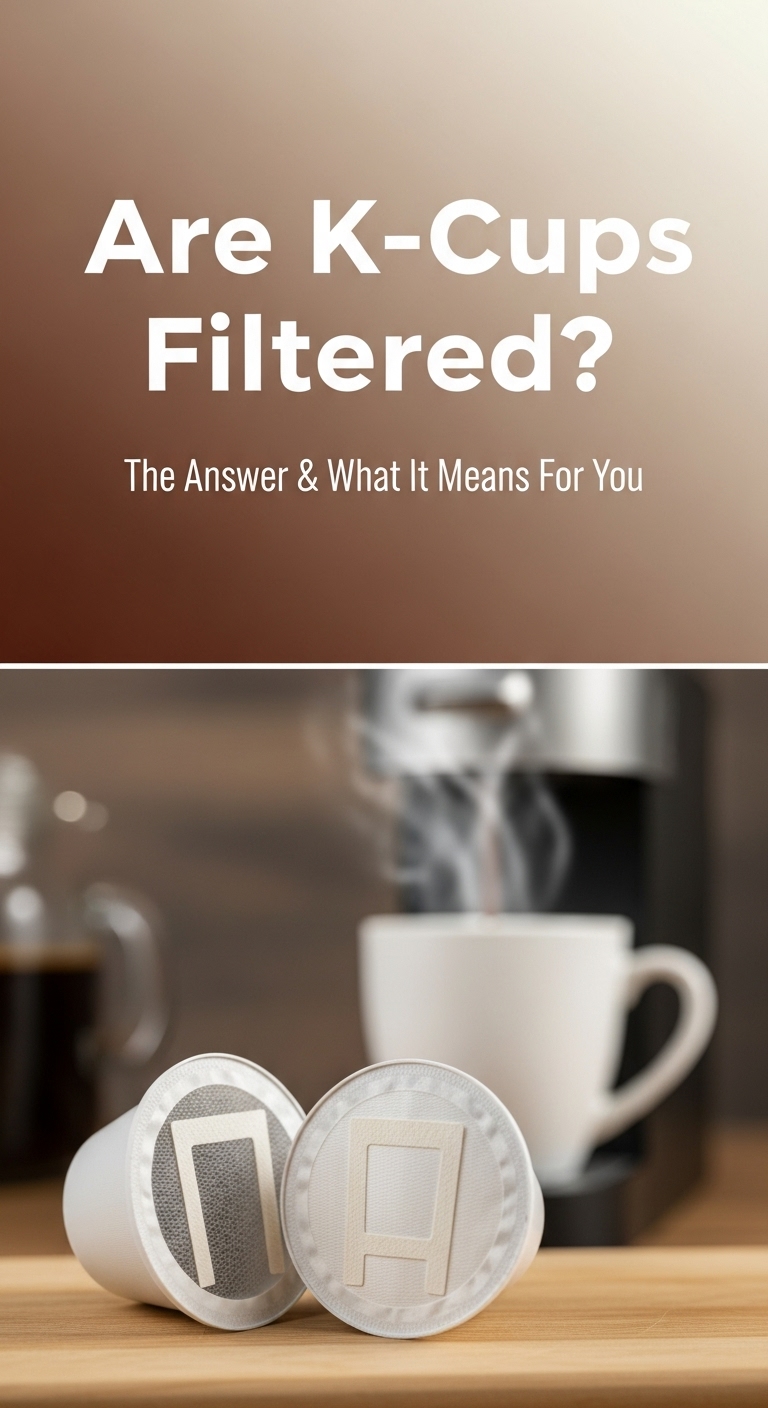As an Amazon Associate CoffeeXplore.com earns from qualifying purchases.
Are K-Cups Filtered? The Answer & What It Means For You
Ever held a K-Cup and wondered what’s really going on inside that tiny plastic pod? You’re not alone. Many coffee drinkers question whether this convenient single-serving brew is truly “filtered” and what that means for the taste, quality, and even health impact of their daily cup.
Yes, K-Cup coffee is filtered. Every pod contains a built-in paper filter that separates coffee grounds from the hot water during the brewing cycle, delivering a clean, sediment-free cup that is functionally similar to a traditional drip coffee maker.
Leveraging extensive analysis of product design and coffee brewing principles, this guide unpacks the complete story of K-Cup filtration. We’ll explore the anatomy of the pod, compare it to other methods, address the critical health questions about cholesterol, and reveal how you can get an even better, more sustainable brew from your Keurig machine.
Key Facts
- Built-In Filtration: Every authentic K-Cup pod is designed with an integrated paper filter that holds the coffee grounds, ensuring the final beverage is free of sediment.
- Cholesterol-Friendly Method: Because K-Cups produce filtered coffee, they remove the vast majority of coffee oils (diterpenes like cafestol) that have been linked in some studies to increases in LDL cholesterol.
- Significant Cost Savings with Reusables: Well-established analysis from sources like Business Insider indicates that switching to a reusable K-Cup filter can save hundreds of dollars annually compared to buying disposable pods.
- Environmental Impact: The convenience of single-use pods has a major environmental downside; reusable filters drastically reduce the amount of plastic waste sent to landfills.
- Total Flavor Control: Reusable K-Cup filters grant you the freedom to use any ground coffee you prefer, allowing for superior freshness, customized flavor, and control over the strength of your brew.
The Direct Answer: Are K-Cups Filtered Coffee?
Yes, K-Cups contain an internal paper filter and produce filtered coffee. This built-in filter separates the coffee grounds from the hot water during brewing, ensuring the final beverage is free of sediment, much like a traditional drip coffee maker. The entire single-serve system is built around this core concept: a pre-measured amount of coffee, perfectly contained within its own filter, ready for a clean and convenient extraction. But how exactly does this tiny pod manage to filter your coffee so effectively?

The Anatomy of a K-Cup: How the Built-in Filter Works
To understand why are k cups filtered coffee, you just need to look inside. While it seems simple from the outside, each K-Cup is a small, precisely engineered brewing system. When you place a pod in your Keurig machine and press brew, a multi-step process begins that relies on each component working perfectly. The filter is the unsung hero of this process.
Here’s a breakdown of the key components inside a typical K-Cup:
- The Plastic Cup: This is the outer shell that gives the pod its structure and holds all the other components together.
- The Foil Lid: An airtight aluminum foil lid seals the pod, keeping the ground coffee inside fresh until you’re ready to brew. The Keurig machine pierces this lid to inject hot water.
- The Ground Coffee: Inside the pod is a pre-measured amount of ground coffee. The grind size is specifically chosen to work best with the pod’s filter and the machine’s brewing time.
- The Paper Filter: This is the critical element. The inside of the plastic cup is lined with a special paper filter. This filter contains the coffee grounds, allowing hot water to pass through and extract flavor while preventing any grounds or sediment from escaping into your mug.
Quick Fact: The filter inside each K-Cup is precisely designed to contain even powdery coffee grounds while allowing for full flavor extraction.
When your Keurig machine forces hot, pressurized water through the pod, the paper filter performs its essential job. It ensures that all you get in your cup is a smooth, clean, and consistent cup of filtered coffee, every single time.
K-Cup Filtered Coffee vs. Traditional Drip Coffee
Many people wonder if Keurig coffee is “like” drip coffee. In terms of filtration, the answer is a resounding yes. Both methods rely on the same fundamental principle: passing hot water through coffee grounds that are held in a paper filter. This core similarity is what gives both brew types their characteristically “clean” cup profile, free of the grit or sludge you might find in unfiltered methods.
However, there are some key differences in the process and results.
| Feature | K-Cup Coffee | Drip Coffee |
|---|---|---|
| Filtration Method | Integrated paper filter inside a plastic pod | Separate paper filter placed in a brew basket |
| Resulting Cup | Clean, smooth, sediment-free | Clean, smooth, sediment-free |
| Brew Size | Single-serving | Multiple cups (batch brew) |
| Convenience | Extremely high; no measuring or cleanup | Requires measuring, filter placement, and basket cleanup |
While both K-Cups and drip coffee makers use a paper filter to separate grounds from the liquid, resulting in a similarly “clean” cup profile, the main distinctions lie in brew volume and convenience. The K-Cup excels at speed and ease for a single cup, while a drip machine is better suited for making coffee for a group.
The Rise of Reusable K-Cup Filters: The Eco-Friendly Alternative
While disposable K-Cups offer unmatched convenience, their environmental impact is a significant concern for many coffee drinkers. This has led to the widespread popularity of an brilliant solution: the reusable K-Cup filter. Reusable K-Cup filters are a popular, eco-friendly alternative that use a durable mesh basket to filter your own ground coffee, offering significant cost savings and reducing plastic waste.
Using one is incredibly simple. Here’s how they work:
- Open the Filter: Most reusable filters have a hinged lid that flips open easily.
- Fill with Coffee: Scoop your favorite ground coffee into the filter’s mesh basket. Be careful not to overfill; most have a marked fill line.
- Brew as Usual: Close the lid and place the reusable filter directly into your Keurig machine’s brew chamber, just as you would a normal K-Cup.
- Clean and Repeat: After brewing, simply empty the used grounds into your compost or trash and rinse the filter. You’re immediately ready for your next cup.
Pro Tip: Many reusable filters are top-rack dishwasher safe, making cleanup nearly as simple as tossing a disposable pod.

Key Benefits of Switching to a Reusable Filter
The advantages of making the switch go far beyond just feeling good about your environmental footprint. The benefits are practical, financial, and can even lead to a better-tasting cup of coffee. The major benefits include significant cost savings over time, a drastic reduction in environmental waste, and the freedom to use any ground coffee you prefer for better taste and freshness.
- Cost Savings: This is often the most compelling reason. The per-cup cost of using your own bulk coffee in a reusable filter is dramatically lower than buying pre-packaged K-Cups. Evidence from publications like Business Insider suggests these savings can easily amount to hundreds of dollars per year for a daily coffee drinker.
- Environmental Impact: Each time you use a reusable filter, it’s one less plastic pod going into a landfill. Over the course of a year, this simple change prevents hundreds of pods from becoming waste, a significant contribution to sustainability recognized by industry sources like Coffee.org.
- Freedom of Choice: You are no longer limited to the brands and blends available in K-Cups. You can buy beans from your favorite local roaster, grind them fresh for maximum flavor, and explore a world of coffee that isn’t available in pod form.
- Control Your Brew: With a reusable filter, you control the amount of coffee you use, allowing you to easily adjust the strength of your brew to be weaker or stronger than a standard pod.
- Durability: High-quality reusable filters are made from durable, long-lasting materials like stainless steel mesh and BPA-free plastic, designed to withstand daily use for years.
The Health Question: Is Keurig Coffee Bad for Cholesterol?
A common question that appears in health-conscious communities is whether Keurig coffee is bad for you, specifically concerning cholesterol. This concern arises from studies on unfiltered coffee. The great news is that because are k cups filtered coffee, they fall into the healthier category in this specific regard.
The key is understanding the difference between filtered and unfiltered coffee.
Unfiltered Coffee: Methods like French press, Cowboy coffee, or Turkish coffee do not use a paper filter. This allows natural oils in the coffee beans, called diterpenes (which include cafestol and kahweol), to pass into the final cup. Some research has linked high consumption of these specific compounds to an increase in LDL (“bad”) cholesterol.
Filtered Coffee: Methods that use a paper filter, like a standard drip machine or a Keurig K-Cup, are very effective at trapping these oily compounds. The paper filter absorbs most of the diterpenes, preventing them from ending up in your mug.
Because K-Cups use a paper filter, they are considered filtered coffee. This process removes most of the coffee oils (diterpenes like cafestol) that have been linked to raising cholesterol, unlike unfiltered methods such as French press.
It’s not about the machine, but the method. This distinction is key for health-conscious coffee drinkers who want the convenience of a Keurig without the potential cholesterol concerns associated with unfiltered brews.
To enhance your brewing experience with maximum flexibility and cost-effectiveness, investing in a set of high-quality reusable K-Cup filters is the smartest move for any Keurig owner.
FAQs About K-Cups and Filtration
Even with the main question answered, you might have a few more specific queries about how K-Cups and filtration work in practice. Here are direct answers to the most common questions.
How do you know if your coffee is filtered?
Generally, if your coffee brewing process involves passing hot water through grounds held in a paper or fine mesh filter, it is considered filtered coffee. This includes common methods like drip coffee machines, pour-over brewers, and Keurig K-Cups. Methods that steep grounds directly in water without a fine filter, like a French press, are considered unfiltered.
Does K-Cup coffee contain coffee grounds or sediment?
No, the internal paper filter in a K-Cup is designed to prevent coffee grounds from making it into your cup, resulting in a clean, sediment-free brew. On very rare occasions, a faulty pod or a buildup of grounds in the machine’s exit needle could allow a few specks through, but this is not normal operation. The system’s entire purpose is to deliver filtered, ground-free coffee.
Are reusable K-Cups as good at filtering as disposable ones?
Reusable filters with their fine mesh baskets are very effective. They prevent all but the finest micro-grounds from passing through, resulting in a cup that is overwhelmingly clean. However, a paper filter will always trap more of the fine sediment and oils than a metal mesh filter. For filtration identical to a disposable K-Cup, some users place a small, disposable paper filter inside their reusable pod for the best of both worlds.
Is Nespresso coffee filtered?
Yes, Nespresso capsules also use a form of filtration, but their system relies on high-pressure extraction to create espresso-style coffee, which differs from the drip-style method of a Keurig. While both are filtered single-serve systems, the resulting coffee is very different. Nespresso produces a concentrated, crema-topped shot, whereas Keurig produces a larger, drip-style cup of coffee.
How sanitary are Keurig coffee makers?
A Keurig is as sanitary as you keep it. While the single-use pods are clean, the machine itself requires regular cleaning to prevent buildup in components like the drip tray and internal lines. The warm, moist environment inside a brewer can be a breeding ground for buildup if not maintained. Regular descaling and cleaning of the pod holder and exit needle are essential for both sanitation and the best-tasting coffee.
Final Summary: Your Coffee, Your Choice—Filtered and Flexible
The answer is clear: Keurig K-Cups definitively produce filtered coffee. The ingenious design of each pod, with its built-in paper filter, guarantees a clean, convenient, and consistent cup every time, free from the sediment found in unfiltered methods. This not only ensures a smooth taste but also addresses health concerns by removing the cholesterol-raising compounds found in unfiltered brews.
But the story doesn’t end with disposable pods. The evolution of the reusable K-Cup filter has revolutionized the Keurig experience, putting the power of choice back in your hands. It transforms your machine from a closed system into an open platform for coffee exploration.
- You now know that every K-Cup has a built-in paper filter, making it a true filtered coffee method.
- You understand that this filtration makes it a better choice than unfiltered coffee for those monitoring their cholesterol.
- Most importantly, you’re aware that reusable filters offer a superior path forward, delivering massive cost savings, reducing environmental waste, and unlocking unlimited coffee choices.
Now that you know the facts about K-Cup filtration, which option—the convenience of disposable pods or the flexibility of a reusable filter—best fits your coffee routine?
Last update on 2025-12-05 / Affiliate links / Images from Amazon Product Advertising API

